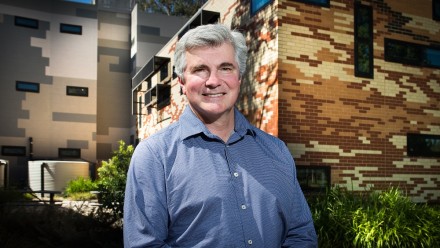Professor Rowena Ball

Contacts
I am an applied mathematician and physical chemist with broad research expertise in nonlinear and complex dynamical systems. My ARC Future Fellowship is entitled - “The charXive challenge and the clean coal quest: thermokinetic principles and methods for capturing and sequestering carbon dioxide." The next 50 years will be the era during which the world's fuels must be decarbonised. Endex thermoreactive principles, which I co-invented in the mid 1990s, are providing a novel technology for separating carbon from fuels and flue gases. I am developing a suite of Endex decarbonation technologies in collaboration with an industry partner, Calix Ltd, and with collaborators from Imperial College London, the University of Leeds, and CanMet Energy. Endex principles also underpin carbon capture from the atmosphere and have been used by nature for millions of years: the mechanism behind thermal decomposition of biomass is an Endex thermochemical oscillator that governs the distribution of carbon between the global solid black carbon reservoir and the atmospheric CO2 reservoir. My research is elucidating this mechanism.
Research interests
- Mathematics Without Borders:
What is mathematics? What is included in mathematics? Who gets to say? How and why did Western mathematics exclusively colonise minds and curriculums over the whole world? Should that situation continue unabated?
In this suite of research projects, available for undergraduate and postgraduate scholars, we investigate the mathematical knowledges of non-Western and Indigenous societies (for an example, see this article posted on the arXiv https://arxiv.org/pdf/2502.15350). We are interested in truth-telling in mathematics history, vernacular mathematical practices, and neurology of mathematical expression. We aim for respectful and collaborative advancement of Indigenous and Western sciences together, walking side-by-side. - Emergence of life – from astrophysical dust formation to proto-biomolecular systems
- Nonlinear and complex dynamical systems, fluctuation physics
- Railways and trains, and I am also quite expert on country pub lunches
Student projects available
1. Topics in non-Western and Indigenous mathematics and mathematics history
2. Problems in complex dynamical systems and emergent behaviour
Projects are available for PhB/ASC and Summer Scholar students, and can be extended to honours/masters/PhD levels
Depending on a student’s background and interests, a variety of projects are available, including but not restricted to the following topics:
1. Topics in non-Western and Indigenous mathematics and mathematics history
- How mathematical knowledge is transmitted: Tracing the transmission of the calculus to Europe from its origin in India and expression by the Kerala school in the 15th century – historical and epistemic modelling approaches, second order effects.
- Modelling Aboriginal smoke telegraphy, and the mathematics, fluid dynamics, and chemical sciences applied by Indigenous smoke experts, and how this can help us understand smoke flows from enhanced wildfires in a warming world, and astrophysical 'smoke' formation and flows. Possible field work involved. As an introduction you can download a little magazine-style piece I wrote at https://arxiv.org/pdf/2502.15350.
We would like to expand the study of smoke telegraphy to include long-distance communication systems of Indigenous societies around the world.
We aim to validate the conjecture that peoples of all societies always understood the need to transform problems in a systematic way, to make them easier, more convenient and accessible.
Investigations on how mathematics is a unique function of the human brain, and the ways in which its expression is essential to all societies: e.g.
It seems that domain transformations are intrinsic to the human brain. When smoke messages are transmitted in the spatiotemporal domain, the receiver directly performs the operation of the Fourier transform on the signal in their optic nerve and brain. What is received and interpreted is the frequency (or wavenumber) spectrum. That is what the recipient needs to know. Smoke is a noisy signal. The receiver’s brain needs to strip away the high frequency, distracting, noise in order to decode, re-code and relay on (in the spatiotemporal domain, i.e., perform the inverse transform) the message with high fidelity.
When Joseph Fourier in the early 19th century ‘invented’ the Fourier transform, what he actually did was to insert the medium and language of written algebra and the calculus between a spatially varying (or time varying) quantity and the human optic nerve and brain. Fourier was working within a cultural space, as were the Indigenous smoke telegraphers. The Fourier transform took off to become ‘the most useful piece of mathematics of all time’, but Western, Eurocentric mathematics and applications completely lost sight of the fact that it was always there. - Non-Gregorian and Indigenous calendars – mathematics and implementation. Calendar making and use is one of the most overlooked topics in mathematics history despite their significance in the development of astronomical and mathematical knowledge and their ongoing economic importance.
- Ethics in mathematics in the era of AI, with Dr Maurice Chiodo, Cambridge University. Background at https://cueims.soc.srcf.net/2025/advanced
- Studies of Indigenous transformations of wayfinding knowledge into the night sky, and the inverse transformation, using graph theory and other tools.
- Cultural concepts of space and Native Title. In Western mathematics, objects called spaces have appeared relatively recently: vector, topological, measured or Banach spaces and so on, definitions of which do not seem to be spatial: they call on algebra, set theory or analysis. When the courts consider Native Title applications, the mathematics of land ownership also seems to be anything but spatial. What is it that is actually being mapped? Is it a set?
2. Problems in complex dynamical systems and emergent behaviour.
- The emergence of life on Earth around 4 billion years ago – modelling an evolving molecular network on mineral surfaces.
- Thermokinetic modelling of growth and decay of dust grains from supernova ejecta.
- The stability of complex networks – what causes a small perturbation to propagate and grow and bring down an entire (transport, communication, biochemical, financial…) network?
Groups
- Researcher, Indigenous peoples, cultures and knowledges







